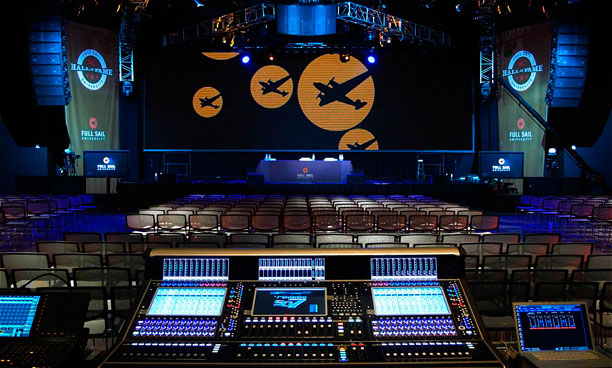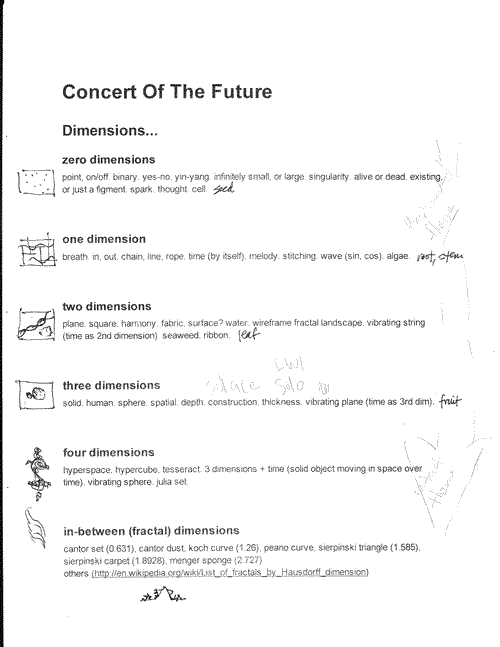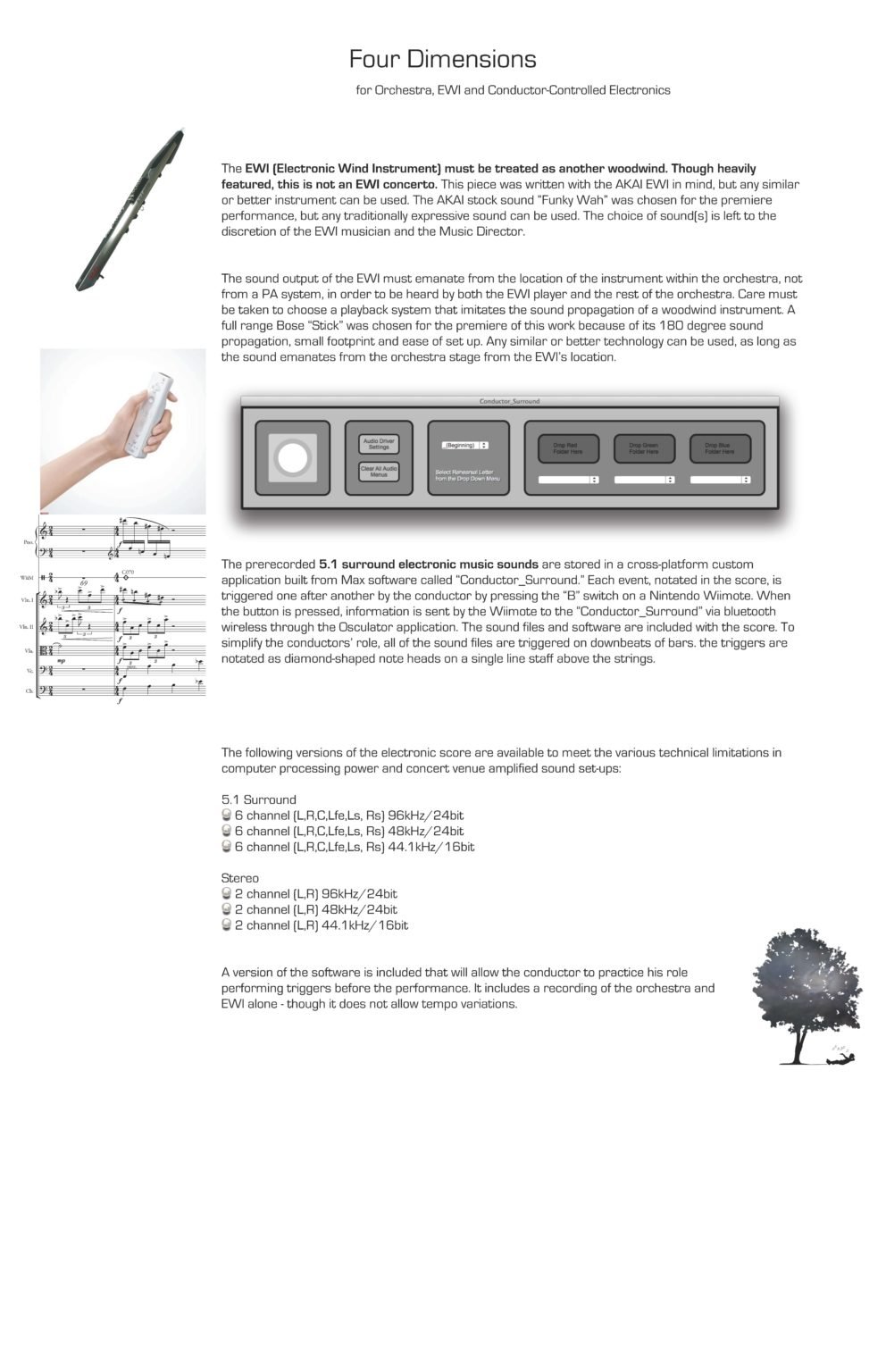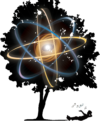The 2012 Orlando Philharmonic's Fundraiser @ Full sail university
In July of 2011, Christopher Wilkins and David Schillhammer, Directors of the Orlando Philharmonic, and I explored ideas about how they might use Full Sail University‘s multi-purpose “Live” venue for the organization’s 2012 fundraiser. It would be the first time a full orchestra would perform in the new facility.

The orchestra generously offered me a small commission for a short work based on some of those ideas. This piece would ‘pull out all of the stops’ in creating an immersive, high powered audiovisual experience. It needed to be short, fun, and entertaining and make full use of the venue’s impressive multi-channel, surround sound system and 48 foot wide LED billboard. I was grateful to the OPO because this commission provided an avenue for my music to finally be heard at the school where I’d taught music for more than 20 years.
Jay Noble, a Director at Full Sail, then pulled together forces from across the school to design and execute a superb show in collaboration with the OPO. Every school discipline got involved in a series of meetings: Concert production, Film, Animation, Graphic Design, Digital Arts, Recording Arts all came together. Faculty would lead students in the production of visual media, set design, staging, lighting, video, and sound. In all, the Gala consisted of twelve pieces that ranged from the standard repertoire to pops, opera, jazz, and modern (my piece). Everything had to be produced and rehearsed by April 21st, 2012.

The Team
The Orlando Phil was to use a 50 pc orchestra and allowed me to hire local electronic wind instrumentalist (EWI), Brian Smithers - a colleague at Full Sail who they already knew and hired as a legit saxophonist. I was allowed to create my own visuals, and was fortunate to have just met Nathan Selikoff at the downtown Urban ReThink Center. We shared a love of math, art, and music (Nathan is also a violinist). He was enthusiastic about the project, and on our first brainstorm, we came up with the Four Dimensions concept: To synchronize the electronic music with the live orchestra performance, I shot for an elegant solution: a device that would follow the conductor's movements. I knew this was out of my skill set and invited MAXdsp specialist, Mark Pinsky, another teaching colleague at Full Sail, to join us. Our tasks were clear. I had to get the score completed and to the orchestra by April 1st, 2012. Nathan and Mark had to have his art ready for rehearsal April 20th. This included getting to know not only the screen resolution and working within it, but all of the limitations and synch issues dealing with a 48 foot monster screen. Mark needed to sort out the best method of synchronizing my surround playback score files to a live orchestra. We all had less than 8 months to do so! Mark Pinsky and I knew MAX DSP was our primary software solution. But we did not know what the best conductor baton solution. Early on, we decided that the inexpensive wii-mote game controller was the best choice.
wii-mote control, ewi sound and visual art research & development
First, the wii-mote sent beat-to-beat tempo data points culled out of accelerometer and orientation data to control the speed of playback of the 6 channel pre-produced sound file. This proved untenable because there was no way to correct playback if it wandered off, and no exact synchronization could be guaranteed to match. Marc then explored better ways to find the beat by mounting the wii-mote in front of the conductor, and using the infa-red camera on the front of the wii-mote to track specific colors at the tip of the baton – even an illuminated one – but the camera quality was too low to sufficiently define the baton’s icti. By February, Marc had been able to define wii-mote data well enough with accelerometer data to provide suitable beat identification – but only if our conductor provided traditional conducting icti. We decided to number each beat in the score, and the software displayed the beat number to the conductor. To simplify the conductor’s tasks, I wrote the work’s tempo to be ‘locked in’132bpm – whether or not the music was rhythmically inactive or active. This proved too complex.
Working with our conductor, Dirk Meyer was wonderful. Dirk was open to the ideas and willing to take the time to work with Marc and I to develop the Wii-mote baton concept. The final version allows the conductor to use their personal baton as normal, while holding a wii-mote in their other hand to physically trigger the files to play.
FInal Score Explanations page

The Electronics in "Four Dimensions"
The electronic music side of the score was composed in Logic and relied on two sources: 1) recordings made in my University of Akron Electronic Music Studio days using 4 track magnetic tape to capture sounds from a large Moog Series III and a smaller Moog Series I and an ARP2600. The other from Logic’s excellent Sculpture synthesis engine based upon acoustic modeling algorithms.
Mark Pinsky built a standalone MAX application (windows or Mac) that plays pre-chunked recordings I created that always beginning on a bar downbeat. This makes any “Four Dimensions” performance very easy to perform, either with the conductor, or a laptop performer on stage.
Of course I want this piece to be performed many times. But few concert halls are as well equipped as Full Sail’s Live Venue. So I created Six packages, half 5.1 surround and half stereo, to allow the technology to ‘fit’ most any scenario. The playback samples are organized in three ‘storage buckets’ red, blue and green so that up to three high-resolution 5.1 file playbacks can happen simultaneously without glitching in any way.
The below video reveals the electronic score with just the EWI, along with showing Nathan Selikoff’s brilliant contribution. Nathan was on the house left side of the stage controlling the art on his phone.
Production
My instrumentation was determined by the orchestra (2-2-2-2 4-3-3-1 Timp, 3perc, harp,pno, strgs). I chose to have the 2nd flute use piccolo and the 2nd clarinet to play bass clarinet throughout and added the EWI to the wind section.
I treated the EWI as a featured wind in the orchestra. To present the proper feel and make ensemble-playing possible, I didn’t want a simple stage wedge monitor. I likes the sound propagation characteristics of. the Bose ‘stick’ line-array loudspeaker because it did a good job imitating the natural acoustic spread of the other woodwinds. (The Bose L1 is the tall black object behind Mr. Smithers house right). The EWI also provided a direct out mono signal.
Instruments were miked in a variety of ways: high strings used DPA clip-on microphones and low strings shared a mic per stand. Brass shared a total of 8 mikes. Percussion shared two, timpani had two of his own; woodwinds shared 1 per stand (4 total); the harp used its own mono DI, and the digital piano sent audio via a direct stereo output. The sound of this performance was excellent – credit to Darren Schneider, Keith Andrews and Mike Stewart for a great film-style live mix made possible through the use of the 60 odd microphones on stage. All of the audio signals were also sent via fiber to the nearby “Audio Temple” studio and recorded to ProTools through a 72 channel SSL Duality console.

